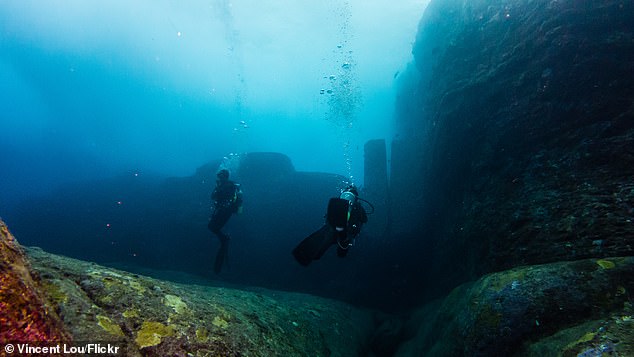A “pyramid” casting near Taiwan can rewrite everything we thought about the ancient world.
Sitting only 82 feet below sea level near the Ryukyu Islands of Japan, a mysterious object called the Yonaguni monument continues not to fall for the researchers and to amaze since its discovery in 1986.
This giant structure with sharp steps measures approximately 90 feet high and seems to be entirely in stone, which leads a lot to believe that it was artificial.
However, stone tests show that it is over 10,000 years old, which means that if a civilization built this pyramid in hand, it would have taken place before this region flowed under water – more than 12,000 years ago.
This would come back further in history than most of the other old structures of several thousand years, including Egyptian pyramids and Stonehenge.
Currently, scientists believe that the ability of ancient humans to build large structures such as temples and pyramids has evolved alongside agriculture development 12,000 years ago.
If an advanced society already built pyramids of giant steps long before this time, however, it could change the history books forever and reveal another lost tribe of man – just like the myths of Atlantis.
In fact, the Yonaguni monument is often called “Japan Atlantis”, but skeptics continue to unravel holes in the theory that this structure was built by human hands.

The Yonaguni monument was discovered by divers almost 40 years ago, about 60 miles east of Taiwan

Although skeptics say that it is a natural rock formation, the Yonaguni monument has a form of pyramid with shocking steps that seem sculpted
The site recently attracted great attention after scientists struck its origins on the Podcast Joe Rogen Experience.
Graham Hancock, an author focused on lost civilizations and the archaeologist, Flint Dibble, debated in the photos of the Yonaguni monument, with dibbles refusing to concede that all the structures found by divers could have been made by humans.
“I saw a lot of crazy natural things and I don’t see anything here that reminds me of human architecture,” said Dibble when he was invited to Rogan’s podcast last April.
“For me, Flint, it’s amazing that you see it as a totally natural thing, but I guess we just have very different eyes,” said Hancock.
Hancock added that the photographs of the dives on the site clearly show human manufacturing arches, megaliths, steps, terraces and what seems to be a “sculpted rock face”.
If the Yonaguni monument was really built by a mysterious civilization over 10,000 years ago, this would add it to the growing list of confusing structures which should have been impossible to build a long time ago.
Built towards the same period, the Yonaguni monument could potentially join the ancient artificial structure of Göbekli tepe in Türkiye as proof of lost civilizations.
This archaeological site of the upper Mesopotamia would have been inhabited from around 9,500 BC to at least 8000 BCE, during the pre-poteral neolithic era.
It is more than 5,000 years before the Egyptian pyramids were built and around 6,000 before Stonehenge.

The sandstone slabs of the Yonaguni monument convinced many researchers in ancient civilizations that an advanced company built a pyramid before the last glacial period

Göbekli tepe in Türkiye was built roughly at the same time that researchers think that the Yonaguni monument would have been built in Asia
Meanwhile, another old structure in Indonesia could prevent Göbekli Tepe and Japanese Atlantis in amazing weather.
Gunung Padang, for the first time rediscovered by Dutch explorers in 1890, would be the oldest pyramid in the world.
Studies show that the “megalith” 98 feet deep has overwhelmed in a hill of lava rocks dates back more than 16,000 years.
In 2023, scientists declared that the structure promised to upset conventional wisdom on the way in which “primitive” hunter -gather societies were really – revealing the real “engineering capacities of ancient civilizations”.
According to Dr. Masaaki Kimura, the case surrounding Japan Atlantis is still open to the debate. Kimura is the scientist who tested the age of sandstone, noting that the rocks go back over 10,000 years.
At this stage of history, the structure would have always been on dry land, before the melting of massive glacial spots had sea level increased at the end of the last glacial period.
Studies show that at the top of the ice age, about 20,000 years ago, sea level was approximately 400 feet less than they are today.
In 1999, however, Dr. Robert Schoch of the University of Boston tried to throw cold water on the theory of an Atlantis in the Pacific, arguing that geology could prove the pyramid and the surrounding “city” was a natural rock formation.

Gunung Padang, called the oldest pyramid in the world, is over 16,000 years old at the top of the last glacial period
Schoch noted in his report that Yonaguni Monument shares a number of characteristics with other nearby geological formations.
In addition, it is found in a region overhanged at earthquakes, 62 miles east of Taiwan, suggesting that fractures and flat faces constituting the “ steps ” are only normal characteristics of the rupture and the separation of sandstone rocks.
“ During the visualization of photographs of the Yonaguni monument, many people immediately have the impression, due to the regularity of the stone faces of the sharp steps and angles manufactured by the rock, that it is an artificial structure ”, admitted Dr. Schoch in his article.
Schoch said that the rocks were also covered with layers of marine life over the centuries, covering a large part of the natural characteristics of sandstone and giving the Yonaguni monument the appearance of being much more uniform than it really is.
“I think this should be considered a mainly natural structure until more evidence is contrary. However, I do not think in any case that this is an absolutely closed case, “he added.


